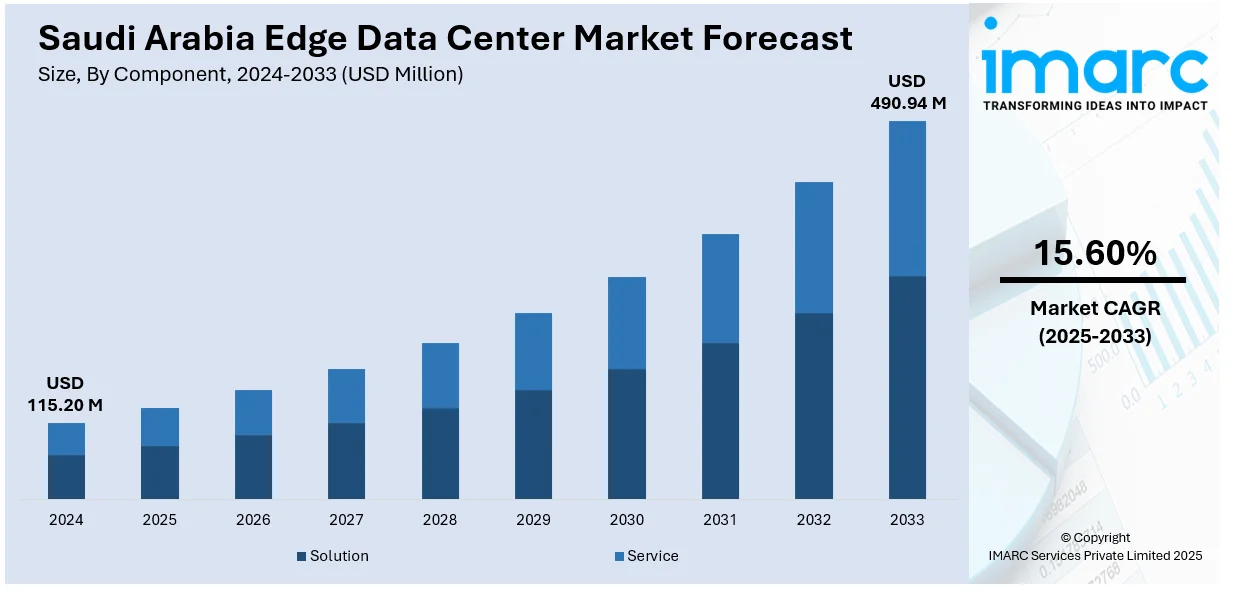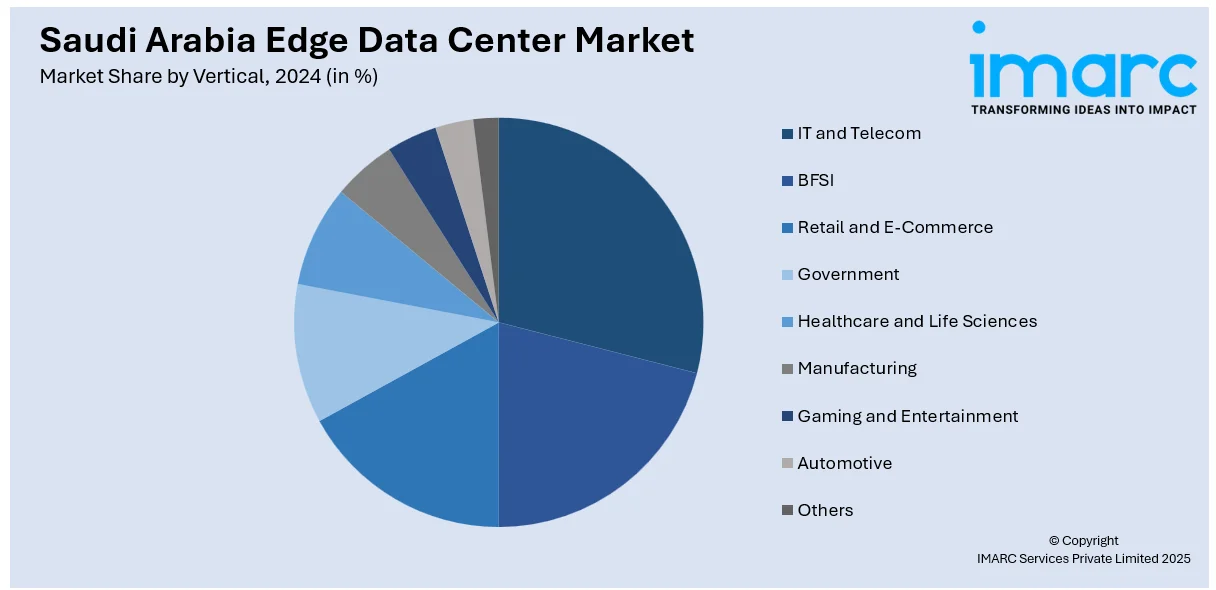
Saudi Arabia Edge Data Center Market Size, Share, Trends and Forecast by Component, Facility Size, Vertical, and Region, 2025-2033
Saudi Arabia Edge Data Center Market Overview:
The Saudi Arabia edge data center market size reached USD 115.20 Million in 2024. Looking forward, IMARC Group expects the market to reach USD 490.94 Million by 2033, exhibiting a growth rate (CAGR) of 15.60% during 2025-2033. The market is driven by increasing demand for low-latency data processing, rapid growth in IoT deployments, and rising investments in smart city initiatives. The government's Vision 2030 plan, which emphasizes digital transformation, is prompting enterprises, telecom operators, and cloud providers to expand localized infrastructure. In addition, rising data traffic, fueled by the 5G rollout and digital service adoption, are key factors augmenting Saudi Arabia edge data center market share.
|
Report Attribute
|
Key Statistics
|
|---|---|
|
Base Year
|
2024
|
|
Forecast Years
|
2025-2033
|
|
Historical Years
|
2019-2024
|
| Market Size in 2024 | USD 115.20 Million |
| Market Forecast in 2033 | USD 490.94 Million |
| Market Growth Rate 2025-2033 | 15.60% |
Saudi Arabia Edge Data Center Market Trends:
Expansion of 5G Networks and its Impact on Edge Infrastructure
The rollout of 5G in Saudi Arabia is fundamentally reshaping the architecture of digital infrastructure, with edge data centers playing a pivotal role in supporting ultra-low latency and high-bandwidth applications. As per industry reports, the nation ranks 13th globally among its peers with a strong 4G/5G availability of 95%, underscoring the robustness of its mobile broadband ecosystem. This extensive coverage provides a solid foundation for enabling next-generation services that depend on localized data processing. As telecom operators accelerate the deployment of 5G networks across both urban and semi-urban areas, there is an increasing requirement for decentralized computing infrastructure that can offload traffic from core networks. Edge data centers are deployed closer to end-users to process and filter data locally, thereby reducing latency, improving throughput, and enhancing application responsiveness. This is propelling Saudi Arabia edge data center market growth. Moreover, 5G’s high device density necessitates greater data processing at the network edge to avoid core network congestion. The synergy between 5G and edge computing is also critical for enabling network slicing and localized service delivery, both of which are vital to mission-critical enterprise applications. This convergence is prompting both public and private sector investments in building micro-edge nodes and localized data facilities.

Rise of Industrial IoT and Demand for Operational Agility
The Saudi industrial sector is undergoing a digital transformation, with sectors such as oil and gas, manufacturing, and logistics adopting Industrial Internet of Things (IIoT) technologies to enhance operational efficiency and predictive maintenance. Edge data centers are critical to processing the massive data volumes generated by sensors, actuators, and industrial control systems deployed across remote and high-risk environments. In oilfields and manufacturing plants, where real-time monitoring of pressure, temperature, vibration, and emissions is essential, edge facilities offer the advantage of immediate data analytics without dependency on distant cloud platforms. This facilitates faster decision-making, reduces unplanned downtime, and enhances worker safety. In September 2024, Qualcomm Technologies and Alat announced a strategic collaboration to enhance AI and IIoT solutions in Saudi Arabia. The partnership focused on developing AI-powered smart devices and IoT modules for industrial environments, aiming to establish Saudi Arabia as a global leader in digital innovation. Such collaborations are strengthening the ecosystem for localized computing infrastructure. Edge computing also supports digital twins, remote asset management, and robotics—core technologies of Saudi Arabia’s Fourth Industrial Revolution strategy—while ruggedized edge facilities align with the geographic dispersion and environmental demands of the country’s industrial zones.
Saudi Arabia Edge Data Center Market Segmentation:
IMARC Group provides an analysis of the key trends in each segment of the market, along with forecasts at the country and regional levels for 2025-2033. Our report has categorized the market based on component, facility size, and vertical.
Component Insights:
- Solution
- Service
The report has provided a detailed breakup and analysis of the market based on the component. This includes solution and service.
Facility Size Insights:
- Small and Medium Facility
- Large Facility
A detailed breakup and analysis of the market based on the facility size have also been provided in the report. This includes small and medium facility and large facility.
Vertical Insights:

- IT and Telecom
- BFSI
- Retail and E-Commerce
- Government
- Healthcare and Life Sciences
- Manufacturing
- Gaming and Entertainment
- Automotive
- Others
The report has provided a detailed breakup and analysis of the market based on the vertical. This includes IT and telecom, BFSI, retail and e-commerce, government, healthcare and life sciences, manufacturing, gaming and entertainment, automotive, and others.
Regional Insights:
- Northern and Central Region
- Western Region
- Eastern Region
- Southern Region
The report has also provided a comprehensive analysis of all the major regional markets, which include Northern and Central Region, Western Region, Eastern Region, and Southern Region.
Competitive Landscape:
The market research report has also provided a comprehensive analysis of the competitive landscape. Competitive analysis such as market structure, key player positioning, top winning strategies, competitive dashboard, and company evaluation quadrant has been covered in the report. Also, detailed profiles of all major companies have been provided.
Saudi Arabia Edge Data Center Market News:
- On February 5, 2025, Microsoft and Aramco Digital have partnered with Armada to roll out its containerized Galleon Edge data centers throughout Saudi Arabia. AI-driven safety monitoring and real-time analytics at Aramco's industrial locations will be supported by these satellite-connected equipment that are integrated with Microsoft Azure services. Enhancing operational effectiveness and data-driven decision-making in Aramco's facilities is the initiative's main goal.
Saudi Arabia Edge Data Center Market Report Coverage:
| Report Features | Details |
|---|---|
| Base Year of the Analysis | 2024 |
| Historical Period | 2019-2024 |
| Forecast Period | 2025-2033 |
| Units | Million USD |
| Scope of the Report |
Exploration of Historical Trends and Market Outlook, Industry Catalysts and Challenges, Segment-Wise Historical and Future Market Assessment:
|
| Components Covered | Solution, Service |
| Facility Sizes Covered | Small and Medium Facility, Large Facility |
| Verticals Covered | IT and Telecom, BFSI, Retail and E-Commerce, Government, Healthcare and Life Sciences, Manufacturing, Gaming and Entertainment, Automotive, Others |
| Regions Covered | Northern and Central Region, Western Region, Eastern Region, Southern Region |
| Customization Scope | 10% Free Customization |
| Post-Sale Analyst Support | 10-12 Weeks |
| Delivery Format | PDF and Excel through Email (We can also provide the editable version of the report in PPT/Word format on special request) |
Key Questions Answered in This Report:
- How has the Saudi Arabia edge data center market performed so far and how will it perform in the coming years?
- What is the breakup of the Saudi Arabia edge data center market on the basis of component?
- What is the breakup of the Saudi Arabia edge data center market on the basis of facility size?
- What is the breakup of the Saudi Arabia edge data center market on the basis of vertical?
- What is the breakup of the Saudi Arabia edge data center market on the basis of region?
- What are the various stages in the value chain of the Saudi Arabia edge data center market?
- What are the key driving factors and challenges in the Saudi Arabia edge data center?
- What is the structure of the Saudi Arabia edge data center market and who are the key players?
- What is the degree of competition in the Saudi Arabia edge data center market?
Key Benefits for Stakeholders:
- IMARC’s industry report offers a comprehensive quantitative analysis of various market segments, historical and current market trends, market forecasts, and dynamics of the Saudi Arabia edge data center market from 2019-2033.
- The research report provides the latest information on the market drivers, challenges, and opportunities in the Saudi Arabia edge data center market.
- Porter's five forces analysis assist stakeholders in assessing the impact of new entrants, competitive rivalry, supplier power, buyer power, and the threat of substitution. It helps stakeholders to analyze the level of competition within the Saudi Arabia edge data center industry and its attractiveness.
- Competitive landscape allows stakeholders to understand their competitive environment and provides an insight into the current positions of key players in the market.
Need more help?
- Speak to our experienced analysts for insights on the current market scenarios.
- Include additional segments and countries to customize the report as per your requirement.
- Gain an unparalleled competitive advantage in your domain by understanding how to utilize the report and positively impacting your operations and revenue.
- For further assistance, please connect with our analysts.
 Request Customization
Request Customization
 Speak to an Analyst
Speak to an Analyst
 Request Brochure
Request Brochure
 Inquire Before Buying
Inquire Before Buying




.webp)




.webp)












